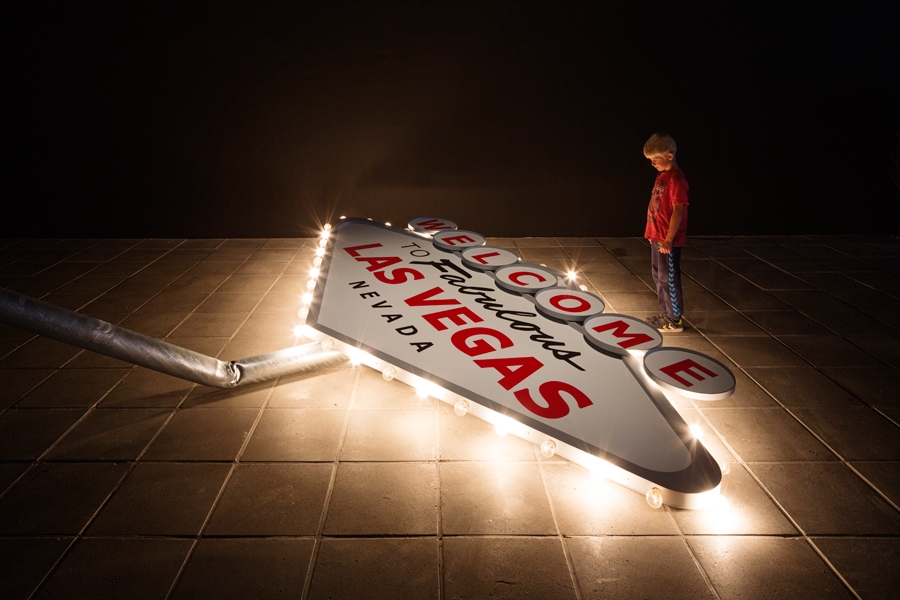‘Welcome to Fabulous Las Vegas’. The flashy sign is smashed to the ground, pole (and concrete base) in the air, message crumpled onto the floor of the darkened gallery. The lightbulbs are still intact, illuminating the Airstream caravan over which the sign has fallen. There is no trace of the owners, but the license plate hints at the ‘Unbridled Spirit’ that took hold of this family from Kentucky. Nearby, behind a chainlink fence, an illuminated swimming pool contains the floating body of a dead man – first seen as part of The Collectors, the makers’ standout work for the 2009 Venice Biennale Danish and Nordic pavilions.
Yet we’re not in Venice, or fabulous Las Vegas, but in Copenhagen, where Michael Elmgreen and Ingar Dragset first started performing some 20 years ago, after meeting in a club named After Dark. Three large-scale installations, each containing new and existing sculptures and objects, make up Biography, the second iteration (the first was at Oslo’s Astrup Fearnley Museum) of what is effectively a mid-career retrospective unfolding through a series of shows (and a book) under that title. The architectural frameworks for each installation suggest fragmented stories from which most of the characters have disappeared: those that remain (as lifelike waxworks) seem to be sleeping or daydreaming; others are dying, one is dead. But by entering the installations, visitors are invited to step into their lives.
A sense of misery persists throughout, but grimness never prevails
A sense of misery persists throughout, but grimness never prevails. Hyperrealistic details give the artworks a larger-than-life quality. A porcelain Rottweiler (The Guardian, 2014) that guards the swimming pool looks exactly like a dog you might find in someone’s garden. In Elmgreen & Dragset’s oeuvre, objects are inverted, their functionality reduced to mere decoration, their details sometimes revealing characters’ personalities. A mazelike installation, made from new and existing works reconfigured as a single installation, brings to mind a public institution, the sterile corridors accommodating objects and public services that don’t function as we would like: picture a ticket office that is closed, a baby left at an ATM, an emergency exit blocked. Seven wrongly designed, dysfunctional doors, part of the socalled Powerless Structures (1997–), offer no way out.
Biography makes for a constant play between social status and the future that life holds. A four-storey apartment building (The One & The Many, 2010) inside the lobby reveals clues about the lives of various inhabitants through its windows (one cannot enter the vast structure). The building entrance contains everyday piles of rubbish, mailboxes and a written note announcing a house party. Most of the citizens seem to have suddenly left their rooms (leaving burning cigarettes in ashtrays, for example), but not a single room – eg, the one with a rice cooker, a TV showing karaoke and a poster picturing an Asian pop star – leaves the voyeur much doubt as to what type of person lives there. No need for acting in this one-dimensional world.
‘Ieder huisje zijn kruisje’ – ‘We all have our troubles’ – is written on the building’s doorbell panel, a souvenir of an installation of the work in Rotterdam in 2011. Ten inhabitants appear on the nameplates, some not as unknown as you might expect: among them collaborators ‘C. Urroz’ director of Arco Madrid, and ‘M. Torp’, curator of Biography. Added twists cannot, however, prevent the wider practice of recycling from affecting the artworks’ significance, too. Flat characters make for empty lives, and once you see that, it doesn’t really matter whether they run off to the casino or drown in their wealth. The one and the many turn out to be the same after all, their private dreams dully predictable if not banal. In another apartment, a screensaver shows images of palm trees and exotic fish. Beside the computer is a globe, on the wall a large poster depicting a young couple kissing on a perfect beach. One leaves the exhibition wondering just who is throwing that house party tonight. If the setting is any indication of the level of conversation – somewhat exaggerated stories told too often – then I’m glad to have missed it.
This article was first published in the December 2014 issue.
